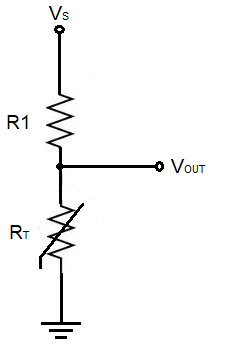NTC Thermistor Voltage Divider Temperature Calculator


This NTC thermistor voltage divider calculator calculates the temperature output by a NTC thermistor voltage divider.
The point of an NTC thermistor voltage divider is to be able to measure the temperature of a system such as a battery management system to monitor the temperature conditions to make sure it's not overheating or anything like that.
This calculator is able to calculate the output temperature according to the fomrula shown above, where the beta value of the NTC thermistor is needed, the temperature of the nominal resistance of the NTC thermistor is needed (normally 25°C or 298.15°K), T0, the nominal resistance of the thermistor, R0, the resistance of the fixed resistor, R1, the supply voltage, VS, and either the voltage output from the voltage divider circuit or the resistance of the thermistor, RT.
The formula shown above is useful for determining the temperature of an NTC thermistor voltage divider. NTC thermistor voltage dividers are commonly used in battery management systems to monitor the temperature of a BMS.
The circuit will output a voltage that ranges in value from the voltage range that a ADC chip can read, commonly 0V-5V but it could also be 0V-3.3V.
The voltage output is proportional to the temperature of the system.
A high voltage output from the circuit near 5V correlates with a cold temperature.
A low voltage output from the circuit near 0V correlates with a hot temperature.
This calculator calculates the temperature in unit kelvin, celsius, and fahrenheit.
Thus, this is a cheap, ideal system for monitoring temperatures
of various systems.
Related Resources
